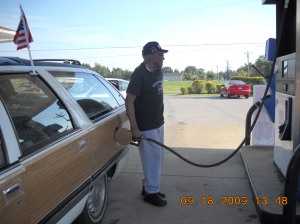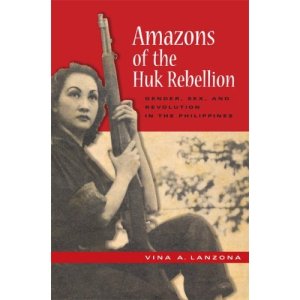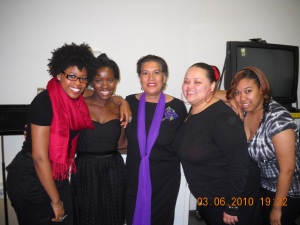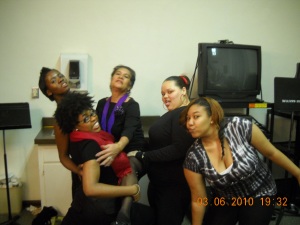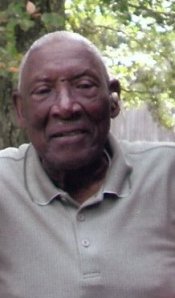Under Wraps: Why Do Women Wear Bras? (A Bracumentary)
– Julie Durazo, Ana Thorne, Erin Wafer
Visual Research Methods
Prof. Alexandra Juhasz
14 April 2010
Very First Time: Making, Thinking, Failure, Success of the Bracumentary
Making
Working backwards from the April 7th due date, Julie Durazo, Erin Wafer and I set a schedule and timeline for the tasks required to film the bracumentary. Our initial meeting took place at Julie’s apartment on Tuesday, March 16. Julie provided fresh fruit and I brought bagels and cream cheese. In this meeting, we discussed and agreed on areas of contribution and tasks for our project. At Erin’s prompt, we decided on the question we wanted to answer in our work – “why do women wear bras?”
To answer this question and several others, we decided to ask it of ourselves and a few friends. We agreed that we wanted a variety of personal views and individual histories, including our own. Julie named the “forum” as the venue in which the women would meet and suggested the Wizard of Bras shop as another resource for taping. Julie, Erin and I represented the issues of finding the best bra for the oversized breast, the smaller breast, and what it might mean to go braless. In addition, Julie and Erin volunteered their moms for the video. We contacted a few friends; however, they were either unwilling or unavailable to participate.
The forum took place on Sunday, March 21st in the Durazo’s lovely home in the hills behind the Rose Bowl and included Carmen Durazo (Julie’s Mom) and Cathy Wafer (Erin’s Mom). Carmen made a large bowl of fresh salsa that we enjoyed with chips and fresh fruit and other goodies that Erin brought. It was my pleasure to meet the entertaining Mr. Durazo who I’ve seen in action on Julie’s blog. In this peaceful and quiet setting, we would pursue the answer to our question.
Sunday started out gray and cool, but the sun came out around noon. While we waited for Erin and Cathy to arrive, Julie and I began preparing and setting up. While the equipment charged, Julie and I decided to tape the forum outside on the patio. While we swept and cleared the area, Julie noticed a deer on the hill in back of the house. After experimenting with a few locations and settings around the patio – taking background, lighting, shadows and the sun into account – we placed the chairs facing the sun and used a large umbrella for shade. Julie set up the camera on a tripod and shot each of us in the forum, taking her seat when it was her turn, and Erin took over the taping task.
We asked the women to give their name, age and bra size as a standard intro. Carmen offered her opinions and experience about oversized breasts and getting the proper support; Cathy shared her encounter with breast cancer and how her relationship with the bra changed following a mastectomy. We were fortunate that both moms were willing to share their experiences with us for this project. Julie echoed her mom’s sentiments; Erin was decidedly undecided on whether she wanted or needed to wear a bra; my position on going braless is a 40-year old habit. The afternoon’s forum taping went better than anticipated and resulted in more material than we could possibly use in the allotted five minutes.
After the forum dispersed, Julie taped the excerpt from my short story, “No Thank You, Otto Titzling” that I suggested we might be able to use in our piece. We taped in her parents’ fluffy and cozy guest bedroom. We also recorded the scene with Julie, her Mom and the corset at this time, and the bra snap that ends the piece.
Julie arranged the taping and interview with Bonnie, founder/owner of the Wizard of Bras in Monrovia on Tuesday, Monday, March 23rd, a day the shop was normally closed. Bonnie took us on a tour of her shop, talked about the history of the bra and women’s undergarments, the market, proper sizing, and her own community efforts to educate women about the importance of wearing the proper bra. While we had prepared a list of questions for Bonnie, we needed to ask only one or two of them because she was willing to share her information and provide market context. Erin and I agreed to participate in a bra fitting so that Bonnie could show how she determines a woman’s proper bra size. This was a revealing experience for both of us who thought we knew our bra size. The bra that Bonnie fitted me with was the most comfortable harness I’ve ever been in. The bra, however, was not a sexy, Victoria’s Secret bra, but rather a sturdy number that formed and held my body from the shoulders to just over the belly button. Erin admitted that the bra Bonnie recommended for her was also very comfortable and made her small breasts look larger. Julie was behind the camera during the 2.5 hours at the bra store which focused on the information Bonnie shared with us about bras, fitting, the market, and her work in the community educating women about proper bra fit. Her store and fitting methods have been featured several times in various media.
With footage from the forum, the Wizard of Bras, and supporting scenes, along with the history, background and images of the bra/breast gleaned from the Internet, we determined that we had more than enough material for our five-minute project, with enough left over for a larger piece if we decided to pursue this topic.
While we divided areas of contribution to the project, all final decisions were made in a collaborative and cooperative spirit. We didn’t always agree on every suggestion of visual/narrative choice. We did, however, discuss the issues until we came to a mutual understanding and accord. Erin agreed to gather a history of the bra; Julie arranged the use of her parent’s home for taping and the interview with Bonnie; I made my short story available to Julie and Erin as a point of reference, agreed to put together a collection of relevant images and statistics, provided drafts of narrative, and suggested a few titles.
Most important, neither Erin nor I had much technical experience and it fell to Julie to take charge of the tapings, music selections and editing. In our meeting of April 2nd at 42nd Street Bagel, and after viewing the first 1:30 edited minutes of the intro, it seemed that the three of us were in sync with what we wanted to convey and that we could trust Julie’s editing judgment. We went through the footage together and suggested beginning/ending points and scenes and dialogue that we thought should be included. We also discussed where we needed voice/over and where the visual would suit our purposes. Each of us made our contribution in different areas of focus: Julie, locations, taping, music, editing and all things technical; Erin, ethics, voice of reason and keeping the project on topic; Ana, writing, timeline and video length. The three of us decided on the flow of the video, its opening, middle content and conclusion.
We met again on April 5th at Hagelbarger’s where our discussion centered on staying close to the allotted allowable time for the bracumentary. We basically agreed to do split screen imaging and narrative in order to compress the visuals and v/over the information taped at the Wizard of Bras. At this point the forum footage was unedited. We went through it and selected what we thought were the most relevant points. I took some notes on our discussion and Julie used these notes for reference in the final edit which depended on her creativity and discretion.
The night before and the morning of our scheduled presentation in class, April 7th, YouTube wouldn’t cooperate and my PC was infected with malicious software that froze the system and bumped me off the Internet. After much persistence, I was able to see the final cut. It was just over seven minutes and I liked it.
Thinking
For me, this project has its most recent genesis in a short story I wrote a couple of years ago. After we’d decided to work on a group project, I suggested we explore the subject of women, breasts and bras. Julie and Erin liked the idea. The research I’d done for the short story included information for medical and non-medical sources that suggested that the wearing of a bra might constrict proper lymphatic flow allowing the build-up of toxins in the soft tissue that might contribute to breast cancer. This concept was broadened to include any/all tight garments on the body. For women this would include bras, panty hose, corsets, girdles, and even shoes. Research also included a long and extensive history of the bra, the issues of breast cancer and the global lingerie market. With several pages of statistics, and facts and figures about the bra, I thought that a visual representation of any conversation about the bra should be a more personal experience, reflecting opinions as individual as each woman who spoke on the subject. The bra/breast is a complex issue and the challenge was how to present its complexity in five minutes of video.
We had discussed having some statistical information on breast cancer and its attendant costs ($28 billion) and stats on the global lingerie/bra market ($29 billion) crawl across the screen with the appropriate visual. However, as the video came together as envisioned by the group and executed in the editing process, it became evident that crawling statistics might decrease the personal and individual impact we had agreed was important to such a short piece. Erin’s insistence on creating a question in the beginning and sticking to it, kept the project centered. And the method for deciding what to include or exclude – visual or narrative – depended upon whether or not it contributed an answer to the question “why do women wear bras?” and that it could do it in the space of a few seconds.
The final product does not include all of the facts and stats we gathered from research; neither does it suffer from the lack. If this piece took the form of a paper, the researched information would be more appropriate for inclusion. The bracumentary is representative and includes our original, collective vision of a reflexive, thought provoking, personal and particular, expandable topic that does not affirm a specific position. Carmen and Cathy contributed strong and sincere statements and I appreciated their enthusiastic support of this project. Julie and Erin are fortunate. Participation in this collaborative and creative effort made me more cognizant of the importance of staying on task, practicing patience, engaging in active listening, willingly compromise, and aiming for clarity in communication.
Failure
My own failure in this project points to the need for more knowledge of the technologies involved in the process and how to use them.
Success
I consider this project a success since it is the first bracumentary in which I’ve been involved:). I am bitten.
Ana

